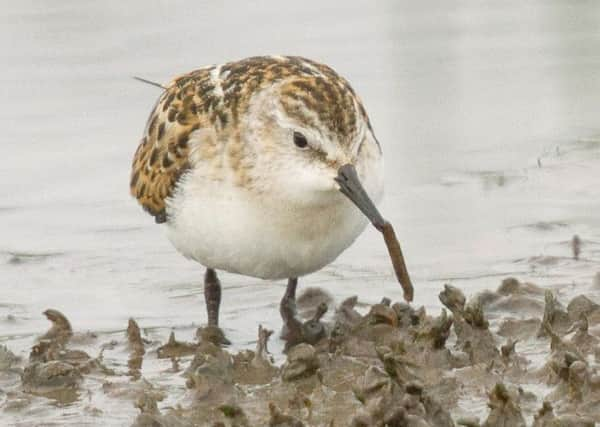Birdwatch: Changing seasons brings tiny waders


Little stints are being seen in good numbers around marshy pools and lakes in many places – normally they are seen singly or in groups of no more than five but up to 12 were gathered this week at Packard’s South on the Hatfield Moor reserve, South Yorkshire.
Little stints are quite easy to pick out from the dunlins with which they often associate.
Advertisement
Hide AdAdvertisement
Hide AdDunlins, which on their own appear quite small waders, look large when feeding next to little stints which are two thirds their size and are the smallest wader that regularly occurs in this country.
Also the little stint has a different feeding action, running about constantly keeping their eyes on the ground and snatching up minute items in their short straight bills at a rate of several to a second – the overall impression is of a bird constantly on the move.
Most of the little stints we see are juveniles which show a distinctive white V among the streaky brown plumage on their backs and have all white underparts.
Given the numbers it appears that little stints, along with other waders that breed in the far north, have had a good season. Last winter around the Arctic was relatively warm and wet so when the waders arrived back from Africa the ground on tundra breeding sites had thawed out so they could take up territories immediately instead of having to wait on the coast for a week or two.
Advertisement
Hide AdAdvertisement
Hide AdIn a good season little stints can lay two clutches, one straight after the other with a male often pressed into service to incubate the first one. The young birds are able to move around and feed themselves within hours of hatching so they are soon off to spend the winter around the Mediterranean and African coasts as far south as South Africa.
Two phalarope species have been seen in the region, a grey at Worsborough reservoir near Barnsley which showed well for photographers, and a juvenile red-necked phalarope at Alkborough Flats on the Humber.
The influx of yellow-browed warblers has continued along the Yorkshire coast this week with 17 in the Spurn area on Tuesday and smaller numbers in many other places. One was seen inland on Sunday in sycamores behind the players’ entrance at Sheffield Wednesday’s Hillsborough ground.
A Radde’s warbler was present on Beacon Lane at Kilnsea, marsh warbler and Richard’s pipit at Spurn and common rosefinch at Crook Ness, Burniston, while other migrants included red-breasted and pied flycatchers, the first ring ouzels of the autumn, song thrushes, robins, and whinchats.
Advertisement
Hide AdAdvertisement
Hide AdA male red-backed shrike was seen at Gristhorpe Bay, Filey, a female over the weekend at the Bempton Cliffs RSPB reserve and a juvenile near the gas terminal at Easington.
A juvenile rose-coloured starling was seen on Beacon Lane at Kilnsea.